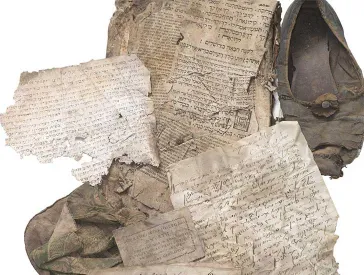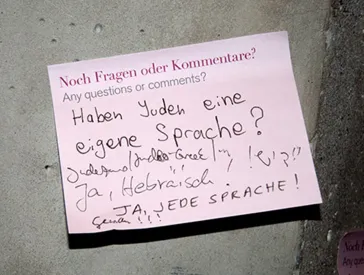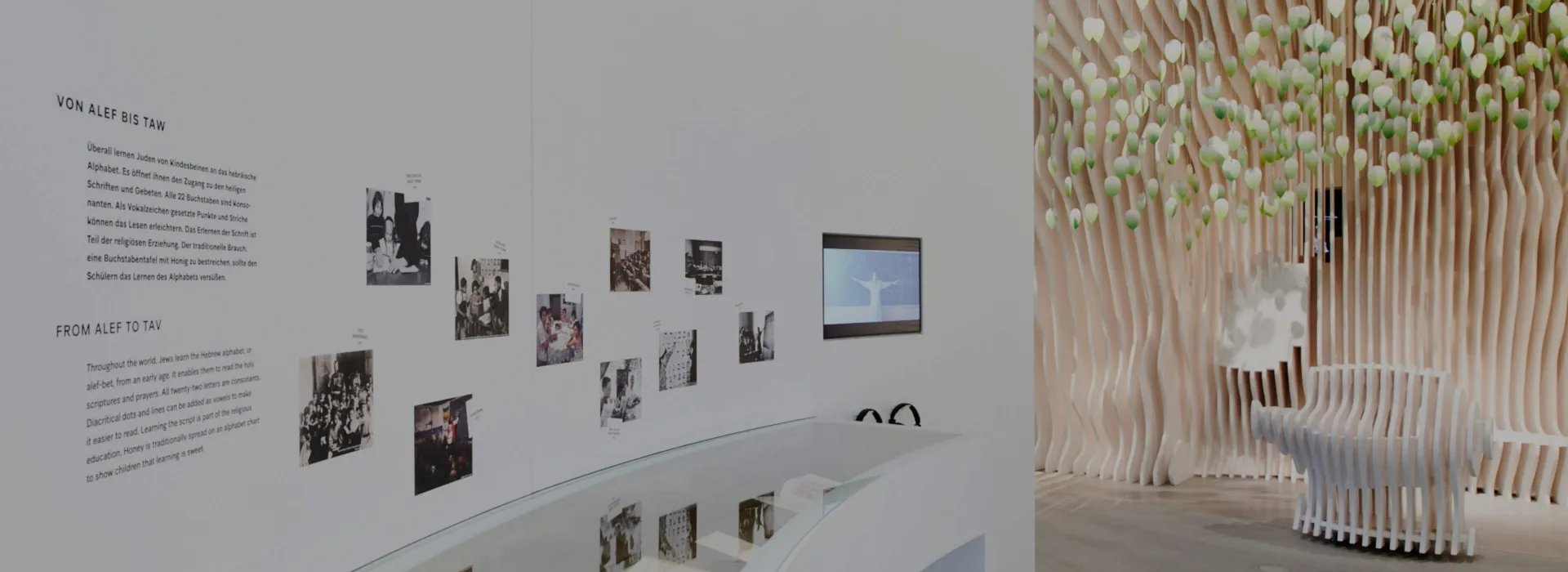
Thematic Space Torah
Words, Writing and Language in Our Core Exhibition
The Torah is Judaism’s most important text and the basis for religious practice throughout the world. The first room in our core exhibition is dedicated to it and a Torah scroll is centrally positioned in the room. In this room you can also learn about the Hebrew alphabet, Jewish languages of the Diaspora, and the concept of a genizah.
On this page, you will find the most important topics, as well as some audio clips and objects.
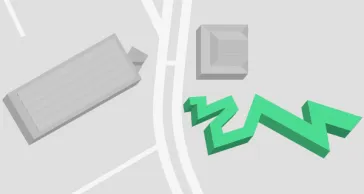
Where
Libeskind Building, level 2, permanent exhibition
Lindenstraße 9–14, 10969 Berlin
The Torah
The Torah is both narrative and law. Its text connects the history of the people of Israel with God’s directives. According to tradition, God revealed the Torah to his people on Mount Sinai.
The parashah, or the weekly portion of the Torah, is at the heart of prayer services. The text is divided into 54 segments that correspond to specific weeks, and it is read in full during the course of the year. Consequently, the Torah scroll is always rolled to the upcoming text passage, taken from the First to the Fifth Book of Moses. On Simhat Torah, literally “Rejoicing with the Torah,” the last chapter of the last Book and the first chapter of the first Book are read together.
A trained Torah scribe, a sofer, uses special ink and a quill to write on the parchment.
The exhibition’s layout references the shape of a Torah scroll; Jewish Museum Berlin, photo: Roman März
Paper Restorer Stephan Lohrengel Talks About the Torah Scroll of the Leavor Family,
Jewish Museum Berlin 2023
Each copy must be accurate and without errors. The writing of a Torah scroll is a sacred undertaking that ensures the text will be passed down faithfully to the next generation.
The Hebrew Alphabet
In order to read the Torah and the prayers, Jewish children learn the Aleph Bet. The Hebrew alphabet has twenty-two letters.
In the exhibition, you can write your name in Hebrew letters. A series of photographs shows different teaching and learning experiences from throughout the world. One display case contains educational materials, from a writing slate to a contemporary Hasidic reading primer.
A Torah scroll, Hohensalza (Inowrocław) 1903; Jewish Museum Berlin, accession 2011/98/0, gift from the Leavor Family in honor of Dr. Hans and Louise Librowicz, photo: Roman März
Hebrew Lessons and Educational Materials
Genizah – Sacred Remnants
A genizah is a final repository for texts and ceremonial objects. The Memmelsdorf Genizah (c. 1725–1830) is on display in our core exhibition. You can learn about it in more detail on our website.
Religious texts that are no longer usable are not thrown out but ritually buried or put into storage.
Prayer for rain, part of the Memmelsdorf Genizah, Memmelsdorf (discovery site), c. 1762–1830; Jewish Museum Berlin, accession 2003/131/26, photo: Roman März
Jewish Languages
Through contact with the surrounding cultures, Diaspora Jews developed Jewish languages that were mostly written with Hebrew letters. The most well-known are Yiddish, Judeo-Spanish (Ladino) and Judeo-Arabic.
In our core exhibition, an world map invites you to explore these languages through sound. The audio clips take you not only to Eastern Europe but also to Yemen and India.
In this episode of the RBB radio show “Zwei auf EINS” (Two to one) dedicated to the opening of the core exhibition, curator Tamar Lewinsky spoke with hosts Daniel Finger and Sven Oswald about Jewish languages; Jewish Museum Berlin, August 2020
Audio Clips of Various Jewish Languages
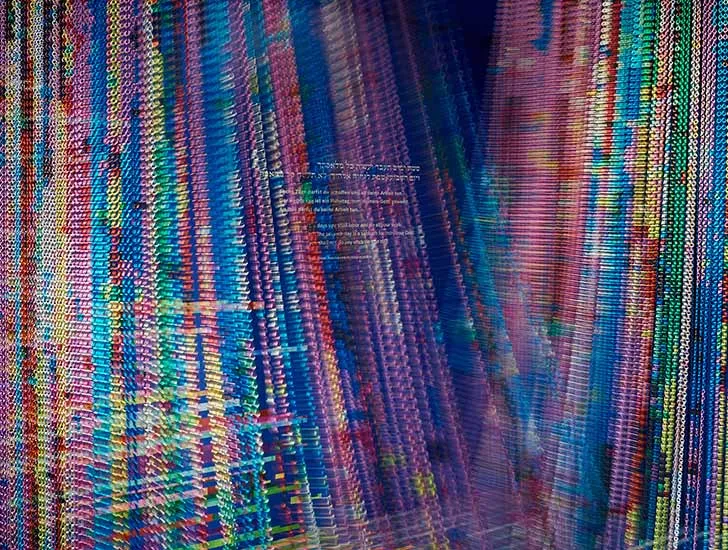
Exhibition Jewish Life in Germany: Past & Present: Features & Programs
Exhibition Webpage
Jewish Life in Germany: Past & Present: Core exhibition of the Jewish Museum Berlin, since Aug 2020
Guided Tours
- JMB App: Audio guide, available in English, German, German plain language, German Sign Language, French, Italian, Spanish, Hebrew and Russian, available for download
- Young Perspectives: Tour Through the Museum in the JMB App, in German and English, available for download
- Guided Tours for Adults as Individual Visitors or in Groups: Fixed dates or by appointment, on site or digitally, in several languages
- Guided Tours and Workshops for School Groups: Appointment, on site or digitally, in several languages
Publications
- The JMB Book: History, architecture and core exhibition of the museum, available in English, German, French, Spanish and Italian
- Open: JMB Journal #21, with interviews and background information on the exhibition
Digital Content
- Current page: Thematic Space Torah: Audios and objects on words, writing and language
- Musicroom: Playlists with religious and secular music from the core exhibition
- Topography of Violence. Antisemitic violence in Germany 1930–1938: Media application from the exhibition’s historical chapter Catastrophe
- 13 Objects – 13 Stories: Unusual objects from our core exhibition
- New Accents: Interview with Cilly Kugelmann, chief curator of the core exhibition

